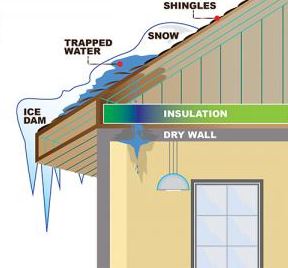December 31, 2025
Snow and Ice Management: Protecting Commercial Roofs and Building Exteriors from Winter Strain
Winter conditions like snow and ice create a very different operating environment for
Icicles and ice dams may be pretty to look at, but they can create issues for your commercial building, whether a hotel, senior living facility, office space or medical office building. Ice dams can cause the tearing off of gutters, loosening of shingles, and enable water to back up into your commercial property. Let’s take a look at what causes ice dams, the potential damage they produce, and how to best prevent them.
Significant snow events can often result in dangerous and destructive ice dams.
Ice damming occurs when water from melting snow runs down the surface of a roof and re-freezes. The melted snow is caused by warm air in the attic space that heats the underside of a roof. Fluctuating temperatures can also play a role in creating snowmelt.
The reason ice-dams form along the roof’s lower edge, usually above the overhang, is straightforward. The upper roof surface (toward the ridgeline) is at a temperature that is above freezing. And the lower part of the roof surface (along the eaves) is below freezing. The upper roof surface is located directly above the living/working space. Heat lost from the building warms this section of the roof, melting snow in this area. During periods of sub-freezing temperature, the lower regions of the roof deck remain at sub-freezing room temperatures.

Ice dams cause millions of dollars of damage every year. Water-stained ceilings, dislodged roof shingles, sagging ice-filled gutters, peeling paint, and damaged plaster are all easily recognized and usually repaired when weather or budgets permit. However, other damage is not as obvious and often goes unchecked.
Ice dams usually develop along roof eaves, above the plate line of exterior walls. Heat lost from building at this point aggravates snow melting and ice-dam development. There are two reasons for increased heat loss at this point: Rafters on most buildings sit directly on top of exterior walls leaving a shallow space for insulation between the top of the wall and underside of the roof sheathing: Low R-value = heat loss! Secondly, builders are not particular when it comes to air-sealing, to prevent the movement of warm indoor air up to the underside of the roof surface. Air can leak through wire and plumbing penetrations here. Warm indoor air can also leak from the wall cavities rising upward and passing between the small cracks that exist between the wall top-plate and drywall.
Roof leaks cause wet attic insulation. Over the long term, water-soaked insulation is compressed so that after it dries, the insulation in the ceiling is not as thick. Thinner insulation means more heat loss, the more heat lost – the more ice dams form – the more it leaks – the more the insulation gets damaged.
Water from ice dams seep into wall cavities. It dampens building materials and raises the relative humidity within wall frames. The moisture within the wall cavity eventually wets interior wall coverings and exterior claddings as it tries to escape (as either liquid or vapor). As a result, interior and exterior walls shed its skin of paint, floors and walls may need to be replaced and the possibility of mold forming if left unchecked is possible.
Check your property carefully when ice dams form. Investigate even when there does not appear to be a leak. Look at the underside of the roof sheathing and roof trim to make sure they haven’t gotten wet. Check the insulation for dampness. When leaks inside your property develop, be prepared. Make sure that the roof sheathing hasn’t rotted or that other less obvious problems in your ceiling or walls haven’t developed. Then create an overall plan to fix the damage and solve the problem.
Pre-season prevention measures such as a roofing underlayment that specifically protects against rain and ice dams or heating strips in drains and downspouts can significantly reduce this risk.
Stopping ice dams is simple: Keep the entire roof at the same temperature as the eaves. Do that by increasing ventilation, adding insulation, and sealing off every possible air leak that might warm the underside of the roof. By taking care of troubled areas, you should enjoy a winter free of ice dams.
Contact BlueTeam today to discuss our roof inspection and maintenance programs.